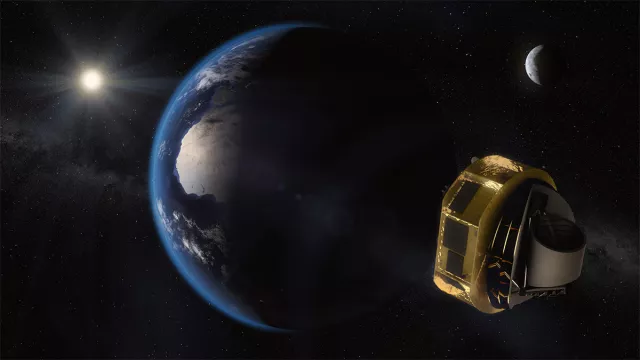After reaching its orbital vantage point 1.5 million kilometres from Earth, the Ariel (Atmospheric Remote-sensing Infrared Exoplanet Large survey) telescope will observe more than a thousand exoplanets to characterize their atmospheres.
Key information
Key figures
- 2 scientific instruments
- 1,000+ exoplanet atmospheres studied
- 1.1-m mirror
- 7 contributing French research laboratories
Key milestones
- 2033: Scheduled end of mission
- 2029: Launch by Ariane 62
- 2023: Phase C, design consolidation and ground tests
- 2021: Phase B2, satellite and instrument definition
- 2020: Project adopted by ESA
- 2018: Project selected for ESA’s Cosmic Vision programme
Project in brief
Ariel was selected in March 2018 as the fourth medium-class mission in the European Space Agency’s Cosmic Vision programme. This space telescope will survey more than a thousand extrasolar planets transiting in front of their star. These exoplanets have already been identified by other satellites or ground observatories. The mission’s main instrument is a visible-infrared spectrometer supplied by France that will probe the atmosphere of gas giant planets to look for clouds, as well as study how the planets interact with their host stars.
After lifting off in 2029 atop an Ariane 62 launcher, Ariel will operate from an orbit around the L2 Lagrange Sun-Earth point, 1.5 million kilometres from our planet, where its telescope will take advantage of the constant illumination and ideal observing conditions. The telescope has an oval-shaped primary mirror with dimensions of 1.1 metres and 0.7 metres. Its components and instruments are protected from solar glare by a multilayer sunshield. After initial operational tests, it will use the transit method to observe known and catalogued exoplanets by detecting the change in brightness as they cross in front of their star.
During such transits, Ariel’s spectrometer will detect the bands in which molecules in the planet’s atmosphere absorb light from its star. Despite its observing targets being tens of light-years away, the telescope will thus be capable of detecting water vapour, carbon dioxide, methane and more exotic metallic compounds, putting the planet in the context of the host star’s chemical environment. The ultimate goal is to better classify exoplanets and their atmospheres according to their common characteristics (star type, orbit, planet type, etc.).
CNES’s role
Within the Ariel project, CNES is responsible on behalf of ESA for supplying the infrared spectrometer being built by the IRFU research institute into the fundamental laws of the Universe at CEA, the French atomic energy and alternative energies commission, with contributions from other French research laboratories including the IAS space astrophysics institute and the LESIA space and astrophysics instrumentation research laboratory.
CNES contacts
Project Leader for French contributions to Ariel
Pascale Danto
E-mail: pascale.danto at cnes.fr
Exobiology, exoplanets and planetary protection subject matter expert
Christian Mustin
E-mail: christian.mustin at cnes.fr


